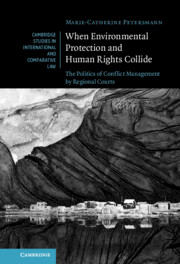 When Environmental Protection and Human Rights Collide
When Environmental Protection and Human Rights Collide Book contents
- When Environmental Protection and Human Rights Collide
- Cambridge Studies in International and Comparative Law 172
- When Environmental Protection and Human Rights Collide
- Copyright page
- Contents
- Acknowledgements
- Table of Cases
- Introduction
- Part I Constructing Synergies: Framing the Environment–Human Rights Interface
- 1 Narratives of Environmental and Human Rights Protection
- 2 Horizons of Synergy
- 3 Constructing and Contesting Anthropocentric Synergies
- 4 Countering the Dominant Frame
- Part II Conflict Mediation through Universalisation
- Conclusion
- Bibliography
- Index
- Cambridge Studies in International and Comparative Law
1 - Narratives of Environmental and Human Rights Protection
From a ‘Pristine Wilderness’ to a ‘Human Environment’
from Part I - Constructing Synergies: Framing the Environment–Human Rights Interface
Published online by Cambridge University Press: 20 October 2022
- When Environmental Protection and Human Rights Collide
- Cambridge Studies in International and Comparative Law 172
- When Environmental Protection and Human Rights Collide
- Copyright page
- Contents
- Acknowledgements
- Table of Cases
- Introduction
- Part I Constructing Synergies: Framing the Environment–Human Rights Interface
- 1 Narratives of Environmental and Human Rights Protection
- 2 Horizons of Synergy
- 3 Constructing and Contesting Anthropocentric Synergies
- 4 Countering the Dominant Frame
- Part II Conflict Mediation through Universalisation
- Conclusion
- Bibliography
- Index
- Cambridge Studies in International and Comparative Law
Summary
Environmental and human rights law emerged as autonomous and disconnected bodies of law with distinct normative underpinnings. Yet, these progressively evolved towards increasing normative interconnections and legal integration. This chapter historicises this evolution by retracing how concerns for environmental protection were legally framed in early environmental instruments and to what end. It then shows how these representations of environmental protection changed over time once they started being articulated in relation to human rights considerations. The analysis draws on early legislative instruments in environmental and human rights law and retrieves the competing rationales at stake in their negotiations, the diplomatic tensions that underpinned their adoptions, and the political and epistemic compromises that were struck to accommodate divergent views over environmental protection and socio-economic development embedded in broader post-colonial debates. The mainstream narrative of environmental protection as translated in modern environmental law is then problematised by demonstrating how specific concerns were accommodated while others were silenced, discarded or neglected. A dominant anthropocentric and synergistic frame emerged, which defines environmental protection as inherently beneficial to human rights. This led to a narrow focus on synergies between environmental and human rights protection, with scant attention paid to conflicts and trade-offs, as the chapter demonstrates.
Keywords
- Type
- Chapter
- Information
- When Environmental Protection and Human Rights CollideThe Politics of Conflict Management by Regional Courts, pp. 17 - 55Publisher: Cambridge University PressPrint publication year: 2022
- 3
- Cited by
